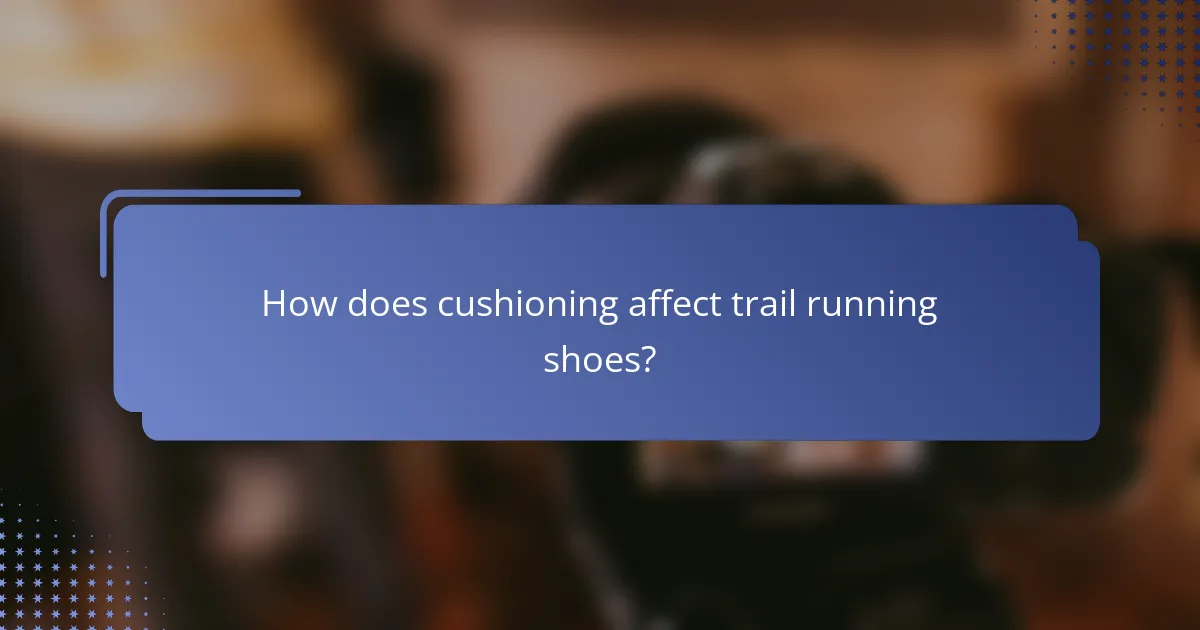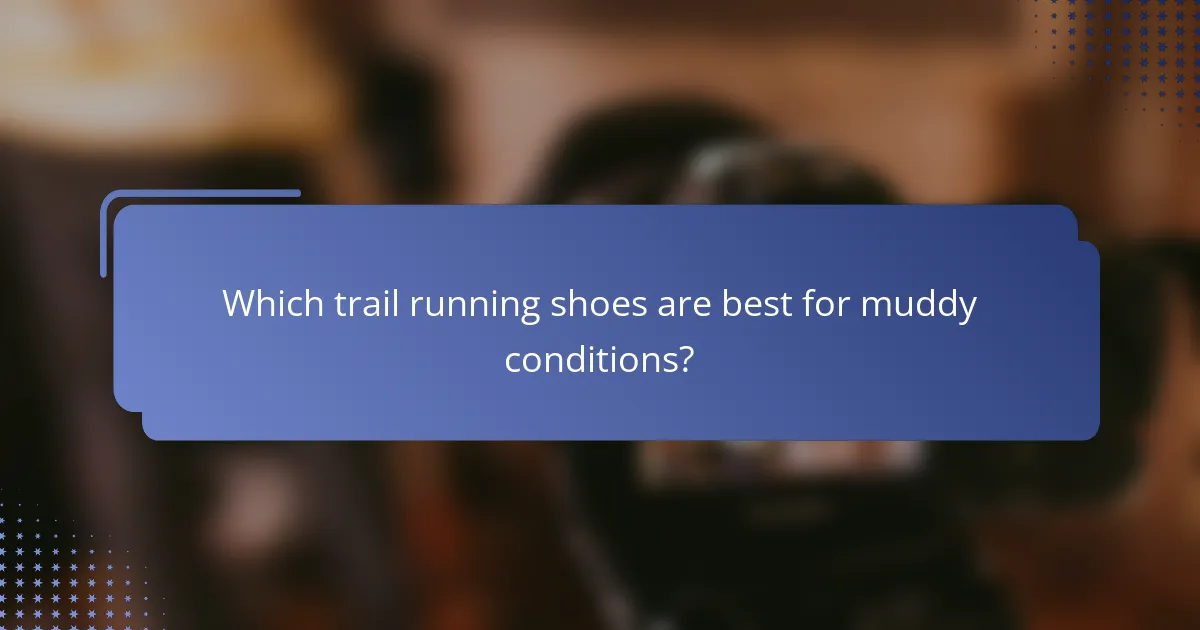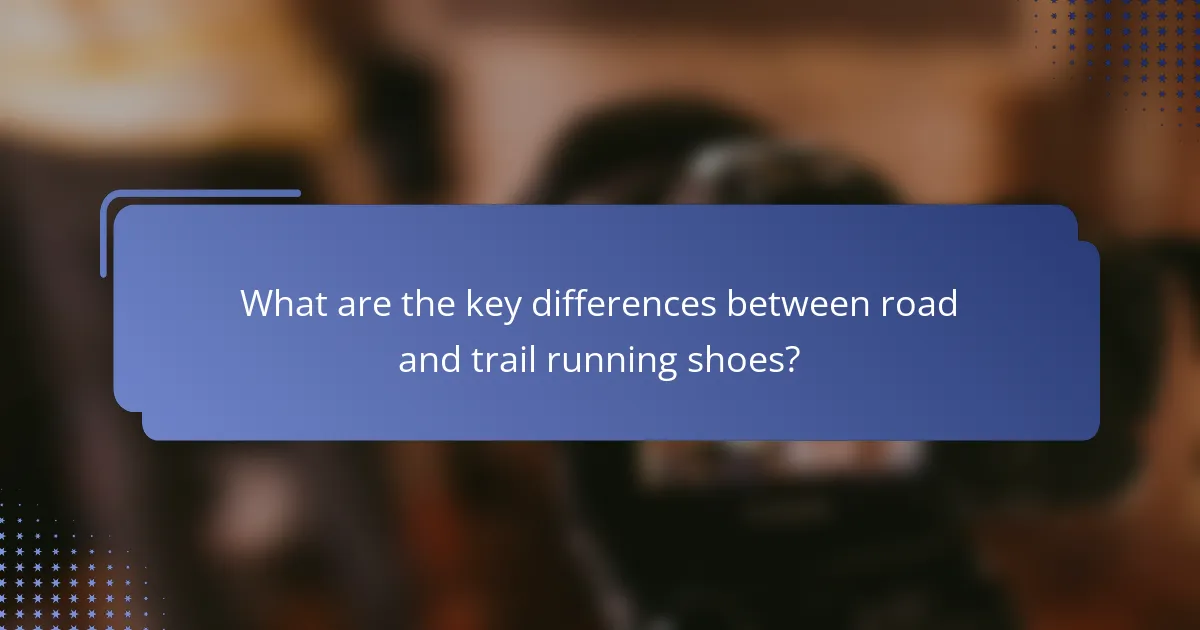Choosing the right trail running shoes is essential for navigating various terrains effectively. Look for features such as robust outsoles for grip, adequate cushioning for comfort, and traction elements to enhance stability on uneven surfaces. These factors will not only improve your performance but also help prevent injuries during your runs.

What are the best trail running shoes for rocky terrain in the UK?
The best trail running shoes for rocky terrain in the UK provide excellent grip, durability, and cushioning to handle uneven surfaces. Look for shoes with robust outsoles and supportive midsoles to protect your feet during challenging runs.
Salomon Speedcross 5
The Salomon Speedcross 5 is renowned for its aggressive traction, making it ideal for rocky trails. Its Contagrip outsole features deep lugs that grip well on various surfaces, ensuring stability and confidence on uneven ground.
This shoe also offers a comfortable fit with a cushioned midsole that absorbs impact, which is essential for long runs on hard surfaces. The quicklace system allows for easy adjustments, ensuring a secure fit throughout your run.
La Sportiva Bushido II
The La Sportiva Bushido II is designed for technical terrain, combining lightweight construction with excellent support. Its FriXion outsole provides exceptional grip on rocky surfaces, while the rock guard protects your feet from sharp objects.
This shoe features a snug fit that enhances stability, making it suitable for steep climbs and descents. The breathable upper keeps your feet cool, which is beneficial during longer runs in varying weather conditions.
Hoka One One Speedgoat 4
The Hoka One One Speedgoat 4 is known for its plush cushioning and wide toe box, making it a great choice for those who prioritize comfort on rocky trails. Its Vibram outsole offers reliable traction, ensuring you can tackle challenging terrains with ease.
This shoe is particularly effective for longer distances, as the cushioning helps reduce fatigue. However, its slightly heavier weight compared to other models may be a consideration for speed-focused runners.

How does cushioning affect trail running shoes?
Cushioning in trail running shoes plays a crucial role in absorbing impact and enhancing comfort during runs. The right level of cushioning can help reduce fatigue and protect against injuries, making it essential for both novice and experienced runners.
Enhanced shock absorption
Shock absorption is vital for trail runners as it minimizes the impact on joints during uneven terrain. Shoes with adequate cushioning materials, such as EVA foam or gel inserts, can significantly reduce the force transmitted to the feet and legs. Look for shoes that offer a balance between cushioning and responsiveness to ensure both comfort and stability.
Consider the terrain you’ll be running on; softer surfaces may require less cushioning, while rocky or hard trails benefit from more shock absorption. A good rule of thumb is to test different levels of cushioning to find what feels best for your running style and the trails you frequent.
Improved comfort on long runs
Comfort is paramount during long-distance trail runs, and effective cushioning can greatly enhance the overall experience. Shoes with ample cushioning help distribute pressure evenly across the foot, reducing hotspots and discomfort. This is particularly important for longer runs where fatigue can set in quickly.
When selecting trail running shoes, consider the type of cushioning that suits your needs. Some runners prefer softer, plush cushioning for maximum comfort, while others may opt for firmer options that provide better ground feedback. Always try on shoes and take them for a short test run to ensure they meet your comfort expectations before committing to a purchase.

What traction features should I look for in trail running shoes?
When selecting trail running shoes, prioritize traction features that enhance grip and stability on various terrains. Key elements include deep lugs and sticky rubber outsoles, which significantly improve your performance on uneven surfaces.
Deep lugs for grip
Deep lugs are protrusions on the outsole of trail running shoes that provide traction by digging into the ground. Look for lugs that are at least 4-6 mm deep for optimal grip on soft or muddy trails. The spacing between lugs is also crucial; wider spacing helps prevent mud buildup, ensuring consistent traction.
Consider the shape of the lugs as well. Aggressive, multi-directional lugs can offer better grip on steep inclines and declines, while flatter lugs may be more suitable for hard-packed trails. Testing the shoe on different surfaces can help determine the best fit for your running style.
Sticky rubber outsoles
Sticky rubber outsoles are made from specialized compounds that enhance grip on both wet and dry surfaces. These outsoles provide better traction compared to standard rubber, making them ideal for technical trails. Look for shoes with a high-friction rubber blend for improved performance in challenging conditions.
When evaluating sticky rubber outsoles, consider the durability as well. While these materials offer superior grip, they may wear out faster than traditional rubber. Balance your choice based on the terrain you’ll encounter most frequently and your running frequency to ensure longevity.

Which trail running shoes are best for muddy conditions?
For muddy conditions, trail running shoes with aggressive traction and water-resistant features are essential. Look for shoes that provide excellent grip on slippery surfaces and have quick-drying materials to keep your feet comfortable.
Inov-8 Mudclaw 300
The Inov-8 Mudclaw 300 is specifically designed for soft and muddy terrains. Its deep, claw-like lugs provide superior grip, allowing runners to maintain traction even in the slickest conditions. The shoe’s lightweight construction helps prevent fatigue during long runs.
Consider the fit and comfort of the Mudclaw 300, as it features a snug design that enhances stability. This shoe is ideal for runners who prioritize performance in challenging environments. However, it may not be the best choice for hard-packed trails due to its aggressive outsole.
Adidas Terrex Agravic
The Adidas Terrex Agravic is another excellent option for muddy conditions, offering a balance of traction and cushioning. Its Continental rubber outsole provides exceptional grip on wet surfaces, making it suitable for unpredictable trails. The shoe’s breathable upper helps keep your feet dry and comfortable.
This model also features a lightweight design, which is beneficial for longer runs. While it performs well in mud, be mindful that its cushioning may not be as firm as other models, which could affect stability on uneven ground. Overall, the Terrex Agravic is a versatile choice for mixed terrain runners.

How do I choose the right trail running shoes for my foot type?
Choosing the right trail running shoes for your foot type involves understanding your arch, heel height preferences, and overall foot shape. Proper fit and support can enhance comfort and performance on various terrains.
Consider arch support
Arch support is crucial for maintaining proper foot alignment and preventing injuries during trail runs. Depending on your arch type—high, medium, or flat—you should select shoes that provide adequate support. For instance, high arches typically benefit from cushioned shoes with a flexible midsole, while flat feet may require stability shoes with firmer support.
To determine your arch type, you can perform a simple wet test: wet your foot and step on a piece of paper. The imprint will help you identify your arch type based on how much of your foot touches the paper. This insight will guide you in selecting shoes that cater to your specific needs.
Evaluate heel height
Heel height, or drop, refers to the difference in height between the heel and the forefoot of the shoe. A lower drop (around 4-8 mm) encourages a more natural running form, while a higher drop (10 mm or more) can provide additional cushioning and support for heel strikers. Your running style and personal comfort should dictate your choice.
Consider testing shoes with varying heel heights to see which feels best during a trial run. If you’re transitioning from road to trail running, starting with a moderate drop may help ease the adjustment while providing adequate cushioning for uneven surfaces.

What are the key differences between road and trail running shoes?
Road running shoes are designed for smooth surfaces, while trail running shoes are built for uneven and rugged terrain. The main differences lie in their outsoles, cushioning, and overall construction to enhance performance and safety on trails.
Outsole design variations
The outsoles of trail running shoes feature deeper lugs and more aggressive patterns compared to road shoes, which have flatter, smoother soles. This design provides better traction on slippery or loose surfaces, such as mud, gravel, or rocky paths. When choosing trail shoes, look for lugs that are spaced appropriately for the type of terrain you will encounter.
For example, shoes with wider lugs are ideal for soft, muddy trails, while those with tighter patterns work better on hard-packed surfaces. Consider the terrain you typically run on to select the right outsole design that meets your needs.
Cushioning differences
Cushioning in trail running shoes tends to be firmer than in road shoes to provide stability and protect against sharp rocks and uneven ground. While road shoes prioritize comfort and shock absorption for repetitive pavement pounding, trail shoes balance cushioning with responsiveness to maintain control on varied surfaces.
Typically, trail running shoes may have a lower stack height, which enhances ground feel and stability. When selecting shoes, consider how much cushioning you prefer and how it aligns with your running style and the types of trails you frequent.

How do terrain types influence trail running shoe selection?
Terrain types significantly affect the choice of trail running shoes, as different surfaces require specific features for optimal performance. Understanding the characteristics of the terrain can help runners select shoes that provide the right balance of support, traction, and durability.
Rocky terrain requires durability
When running on rocky terrain, shoes must be durable enough to withstand sharp edges and abrasive surfaces. Look for shoes with reinforced toe caps and robust materials that can resist punctures and wear. A thicker outsole can also enhance protection against sharp rocks.
Additionally, consider shoes with a stiffer midsole to provide stability and support on uneven ground. A good fit is crucial; ensure the shoes are snug but not overly tight to prevent blisters during long runs.
Muddy terrain needs aggressive traction
Muddy terrain demands shoes with aggressive traction to prevent slipping and maintain grip. Opt for shoes with deep lugs and a rubber outsole designed to channel mud away, enhancing grip on slippery surfaces. The tread pattern should be spaced adequately to avoid clogging with mud.
When selecting shoes for muddy conditions, prioritize lightweight options that dry quickly to reduce fatigue. Waterproof features can be beneficial, but ensure they do not compromise breathability, as moisture can accumulate inside the shoe during long runs.

What brands are leading in trail running shoe technology?
Several brands are at the forefront of trail running shoe technology, known for their innovative designs and performance features. Key players include Salomon, Hoka One One, and Altra, each offering unique advantages tailored to different terrains and runner preferences.
Salomon
Salomon is renowned for its high-performance trail running shoes that excel in rugged conditions. Their shoes often feature advanced traction systems, such as Contagrip, which provide excellent grip on wet and dry surfaces, making them ideal for varied terrains.
When choosing Salomon shoes, consider the fit and cushioning options available. Models like the Salomon Speedcross are designed for aggressive trail running, while the Sense Ride series offers a more balanced cushioning for longer distances. It’s important to select a model that aligns with your running style and the specific trails you frequent.
Additionally, Salomon shoes often incorporate quick-lacing systems that enhance convenience and ensure a snug fit. This feature can be particularly beneficial during long runs, as it minimizes the risk of discomfort from loose laces. Always try on different models to find the best fit for your foot shape and running needs.



